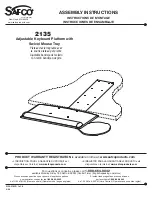
18, Bansong-ro 513Beon-gil, Haeundae-gu, Busan, Republic of Korea, 48002
www.autonics.com | +82-51-519-3232 | [email protected]
-|Transparent Guide|-
Troubleshooting
Malfunction
Cause
Troubleshooting
It is not work.
Power voltage
Check the power cable and adjust
power voltage.
Cable cut, disconnection
Check wiring and terminals.
Rated sensing distance
Use it in rated sensing distance.
Sometimes it does
not work.
Pollution by pollutant on the
lens of Emitter/Receiver.
Remove the pollutant.
The door is opened
even if people do not
enter in the sensing
area.
Rated sensing distance
Use it in rated sensing distance.
There are obstacles between
Emitter and Receiver.
Remove obstacles.
There are equipments generating
strong noise or ratio wave (motor,
neon lamp, generator and high-
tension wire, etc).
Keep away from the equipment
generating strong noise or ratio
wave.
Operation Indicator
Entry activation
Power
OFF
Out of the
sensing area
01)
Enter the
sensing area
Out of the
sensing area
02)
Operation indicator
(red, green)
OFF
ON
OFF
ON
Output
contact
N.O.
OPEN
OPEN
CLOSE
OPEN
N.C.
CLOSE
CLOSE
OPEN
CLOSE
01) It operates in the normal. None of the person or the object is in the between sensors.
02) The state after the person or object has passed.
Sensitivity Adjustment
This function helps to set the sensitivity in the situation that if the malfunction occurs
due to the lack of sensitivity, when installing this unit at first or during operation.
Depending on the sensing distance, the controller automatically sets the optimum
sensitivity for the best operation.
■ Steps of the sensitivity setting
• When pressing the sensitivity setting key below 1 sec, the sensitivity setting is
canceled and it operates as the latest setting.
• If sensitivity is not enough or the setting is not correct, this unit may have
malfunction.
Sensitivity
setting key
Press sensitivity
setting key (TEACH)
After 1 sec.
during pressing
sensitivity setting
key
Completes
the process of
the key
Sensitivity
setting
indicator
01)
Red/green indicator
cross-flashing
Red/green indicator
all OFF
Indicates
operation status
Red/green indicator
flashing at the same time
Statue
Ready for
sensitivity setting
Starts
sensitivity setting
Completes
sensitivity setting
01) The indicator may vary depending on the channels. See the 'Sensitivity Setting Indicators.'
■ Cautions during the sensitivity setting
• Check there are obstacles between Emitter / Receiver heads.
• Check there is dirt on the head lens of Emitter / Receiver.
• Check the wires are disconnected or connected properly as the label (nameplate).
• Check the heads of Emitter/Receiver are inclined.
• Check the above items and resolve the problems and set the sensitivity again.
Dimensions
• Unit: mm, For the detailed drawings, follow the Autonics website.
•
part is only for ADS-SEC2.
■ Controller (ADS-SEC□)
7.6
19
2-4.4
44
77
69
24
■ Sensor (ADS-SHP)
• One push method
•
Screw method
15
Ø 2.4, 10 m
150
1.7
Ø 15
Ø 11.4
Ø 2.4, 10 m
M10×0.75
15
11.5
150
2
Ø 11.4
Unit Descriptions
<ADS-SEC1>
<ADS-SEC2>
<ADS-SHP>
1
2
4
3
5
7
7
6
6
Sensor body
Sensor head
Lens
Nut
Head
holder
1
OUT 1 indicator
2
OUT 2 indicator
3
Sensitivity setting key (TEACH)
4
Wiring connection
button
5
Mounting hole
6
Power and output connection
terminal (1 to 5)
7
Emitter/Receiver sensor
connector terminals
01)
01) ADS-SEC1: 6 to 9, ADS-SEC2: 6 to 13
Sold Separately: Mounting Bracket
• Unit: mm, For the detailed drawings, follow the Autonics website.
■ ADS-SB12 (one push method)
■ ADS-SB10 (screw method)
M4 flat head
cap screw
50
40
24
Ø 12.2
M4 flat head
cap screw
24
M10×0.75
50
40
Sensitivity Setting Indicators
Connected
channel
Indicator
Status
OUT1 (red) OUT2 (green) After setting the
sensitivity
In operation
1 CH
ON
OFF
Sensitivity setting
success
Received light
Flashing
Flashing
Sensitivity setting
failure
Emitter disconnection or
sensor cable extension
Flashing
OFF
-
Lack of sensitivity
OFF
OFF
-
Interrupted light
2 CH
ON
ON
1, 2 CH: sensitivity
setting success
1, 2 CH: received light
ON
Flashing
1 CH: success,
2 CH: failure
2 CH: lack of sensitivity
ON
OFF
-
1 CH: received light,
2 CH: interrupted light
Flashing
ON
1 CH: failure,
2 CH: success
1 CH: lack of sensitivity
OFF
ON
-
1 CH: interrupted light,
2 CH: received light
Flashing
Flashing
1, 2 CH: sensitivity
setting failure
1, 2 CH: lack of sensitivity
or emitter disconnection
OFF
OFF
-
1, 2 CH: interrupted light
• For ADS-SE2, OUT 1 indicator (red) is for the receiver status set by the emitter of 1-channel
and OUT 2 indicator (green) is for the receiver status set by the emitter of 2-channel.
• If the lack of sensitivity occurs by not-matched optical axes or pollution on the lens of
emitter / receiver during self diagnostic function, for ADS-SE1, the OUT 1 indicator (red)
flashes. For ADS-SE2, the OUT indicator of the channel with the lack of received light
flashes.





















